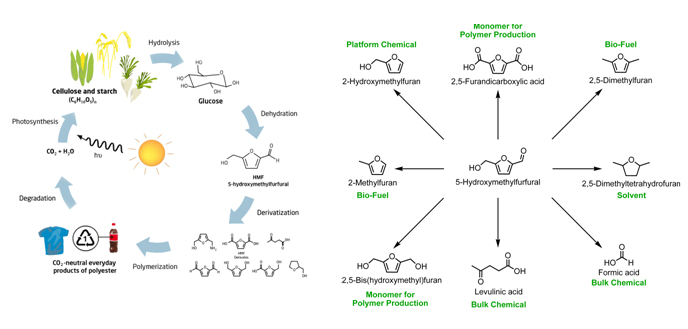Catalytic Conversion of Biomass to Value-added Chemicals
Today practically all chemicals are made from a very limited range of basic compounds with fossil-based origins. In order to shift from a fossil-based chemical industry towards a sustainable and carbon-neutral technology, a new chemical infrastructure has to be created based on the only sustainable carbon-source, namely biomass. A promising approach towards a new chemical infrastructure is the catalytic dehydration of carbohydrates, which comprises a large percentage of the available biomass and therefore is an abundant source.
Sugars with five and six carbons have been under certain scrutinity since they are abundant in nature as parts of polymers such as cellulose, hemi-cellulose, starch and lignin. One molecule that has attracted particular attention as a possible renewable platform chemical is 5-hydroxymethylfurfural (HMF). It is formed by the dehydration of hexoses such as glucose and fructose and is acknowledged to be a precursor for solvents, fine chemicals as well as plastics.

Today practically all chemicals are made from a very limited range of basic compounds with fossil-based origins. In order to shift from a fossil-based chemical industry towards a sustainable and carbon-neutral technology, a new chemical infrastructure has to be created based on the only sustainable carbon-source, namely biomass. A promising approach towards a new chemical infrastructure is the catalytic dehydration of carbohydrates, which comprises a large percentage of the available biomass and therefore is an abundant source.
Sugars with five and six carbons have been under certain scrutinity since they are abundant in nature as parts of polymers such as cellulose, hemi-cellulose, starch and lignin. One molecule that has attracted particular attention as a possible renewable platform chemical is 5-hydroxymethylfurfural (HMF). It is formed by the dehydration of hexoses such as glucose and fructose and is acknowledged to be a precursor for solvents, fine chemicals as well as plastics.
Selective Aerobic Oxidations with Gold Catalysis
Until recently metallic gold was considered essentially unreactive. However, during the last decade it has been shown that gold nano-sized particles are surprisingly active and selective catalysts for several oxidation reactions with molecular oxygen in particular.
Oxygen is considered a “green” oxidant because it produces water as the only by-product. From an economic point of view, aerobic oxidation is also very attractive due to the low cost of air and its unlimited accessibility. In organic chemistry, the oxidation of alcohols is one of the most important reactions. However, many of these oxidations are usually carried out using stoichiometric amounts of high-valent metal oxides, e.g. manganese or chromium oxides, which produce a huge amount of waste in term of metal atoms. To provide a practical and environmentally friendly alternative to these classical oxidations we have invested considerable effort in the development of aerobic oxidations.

Projects at all levels are offered within Renewable Chemicals regarding gold-catalyzed conversion of renewable alcohols into carboxylic acids and derivatives as exemplified above. Depending on project direction and aim, projects will take place in cooperation with Danish companies.